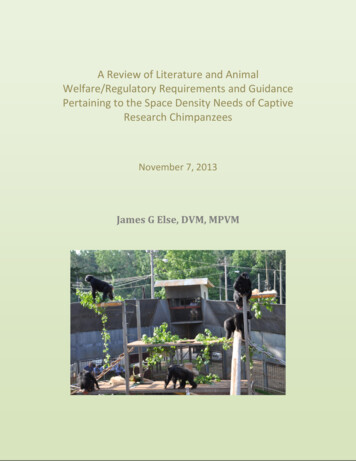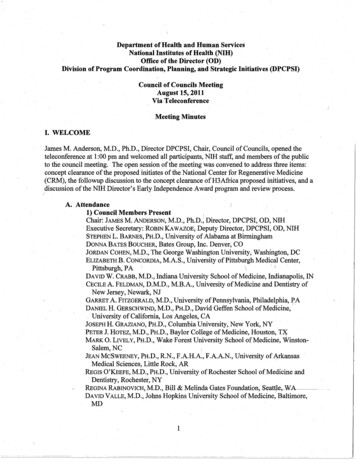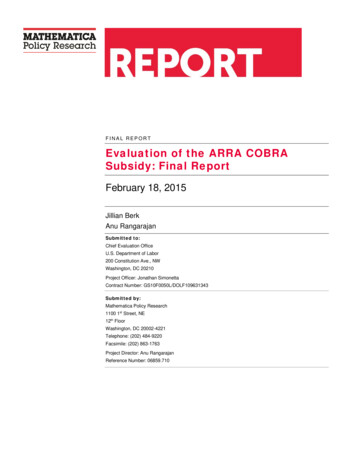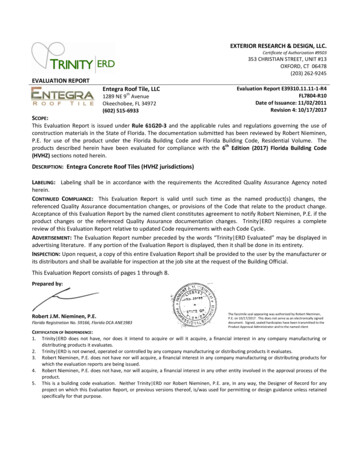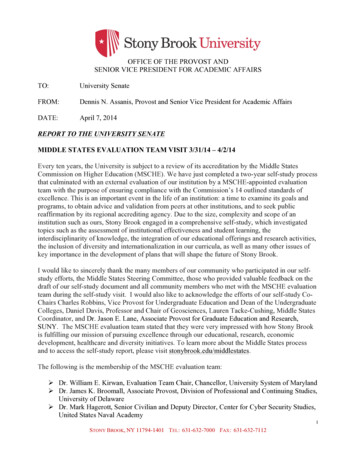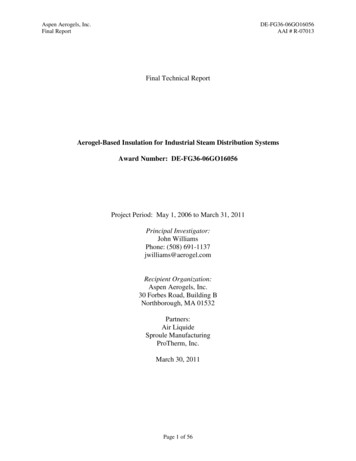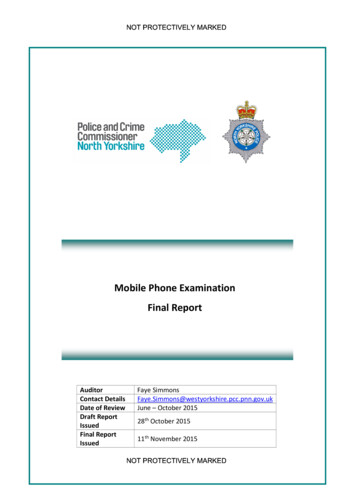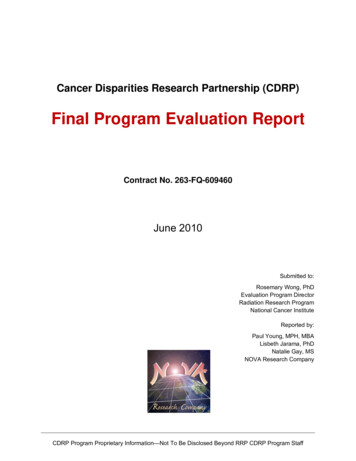
Transcription
Cancer Disparities Research Partnership (CDRP)Final Program Evaluation ReportContract No. 263-FQ-609460June 2010Submitted to:Rosemary Wong, PhDEvaluation Program DirectorRadiation Research ProgramNational Cancer InstituteReported by:Paul Young, MPH, MBALisbeth Jarama, PhDNatalie Gay, MSNOVA Research CompanyCDRP Program Proprietary Information—Not To Be Disclosed Beyond RRP CDRP Program Staff
Table of ContentsEXECUTIVE SUMMARY .4CANCER DISPARITIES RESEARCH PARTNERSHIP PROGRAM FINDINGS .121.INTRODUCTION.121.1BACKGROUND .121.2CDRP PROGRAM PURPOSE AND GOALS .121.2.1Innovative Funding Model.131.3COMMUNITY-BASED GRANTEES .132.CDRP PROGRAM EVALUATION .152.1EVALUATION PURPOSE AND DESIGN .152.1.2Evaluation Study Questions .152.2METHODS AND PROCEDURES .162.2.1Quarterly Data Report and Clinical Research Summary Spreadsheet.162.2.2Interview Data .162.2.3Annual Progress Reports, Clinical Trials Operations Committee Supplement Progress Reports, andU54 Applications .172.2.4Comparison Site Survey.182.3DATA LIMITATIONS .182.4DATA ANALYSIS .192.4.1Quantitative Data .202.4.2Qualitative Data .203.EVALUATION FINDINGS .203.1CDRP PROGRAM ACHIEVEMENTS.203.1.1Building/Stabilizing Clinical Trial Research Infrastructure.203.1.2Clinical Trials.213.1.3Patient Accruals.233.1.4Other Clinical Research .293.1.5Partnership/Mentorship.303.1.6TELESYNERGY .323.1.7Patient Navigation .333.1.8Community Outreach.363.1.9New Funding/Professional Development Opportunities.373.1.10 Special Accomplishments.383.1.11 Funding Mechanism .403.2OUTCOMES AMONG COMPARISON SITES .403.2.1Clinical Trials.403.3CDRP PROGRAM CHALLENGES .433.3.1Special Circumstances—Centinela Freeman.433.3.2Building/Stabilizing Clinical Trials Research in Community-Based Institutions .433.3.3Clinical Trials and Patient Accruals .443.3.4Partnership/Mentorship.453.3.5TELESYNERGY .453.3.6Data Collection/Reporting.45NOVA Research Company, April 26, 2010Page 2 of 79
3.4BEST PRACTICES AND LESSONS LEARNED .463.4.1Best Practices .463.4.2Lessons Learned 2Radiation Oncology Clinical SYNERGY .503.5.5Patient Navigation .503.5.6Community Outreach and Navigation .503.5.7Data Collection/Reporting.503.5.8Evaluation of Program Success .513.5.9Sustainability .513.6CONCLUSIONS .513.7CDRP SITE PROGRESS .533.7.1Rapid City Regional Hospital .533.7.2Centinela Freeman Regional Medical Center .563.7.3New Hanover Regional Medical Center .563.7.4Singing River Hospital.563.7.5UPMC McKeesport Hospital.563.7.6Laredo Medical Center.563.8PI REFLECTIONS ON THE U54 CDRP CONTINUATION PROCESS .564.LIST OF APPENDICES.56Appendix A: CDRP Program Conceptual FrameworkAppendix B: Evaluation MatrixAppendix C: Performance and Management Review of NOVA Evaluation ActivitiesAppendix D: Quarterly Data Report and Clinical Trial and Research Summary SpreadsheetAppendix E: Comparison Site SurveyAppendix F: Reports from In-Depth Interviews with PIs and PartnersAppendix G: Peer-Reviewed Publications Related to CDRPNOVA Research Company, April 26, 2010Page 3 of 79
EXECUTIVE SUMMARYThe National Cancer Institute’s (NCI) Cancer Disparities Research Partnership (CDRP) Program wascreated to help reduce the significant negative consequences of cancer health disparities by providingstate-of-the-art radiation therapy and radiation oncology clinical trials. The CDRP Program was a 5-yearU56 Cooperative Agreement conducted by the Radiation Research Program (RRP) within NCI’s Divisionof Cancer Treatment and Diagnosis (DCTD). The funding mechanism for the CDRP Program was uniquein that awards were made to community cancer care facilities that had not traditionally been involved inNCI-sponsored research. Unlike “top down” models where funding is provided to cancer centers and thento disparities sites, CDRP reversed the flow of research dollars with disparities sites choosing theirmentoring partner(s).The CDRP Program sought to build radiation oncology clinical research capabilities in communityinstitutions; prepare scientists in radiation oncology clinical research; increase clinical trial participation ofblack/African-American, Hispanic/Latino, Native American, Asian, elderly, and low-income populations;provide quality cancer care to disparate populations; and build partnerships between academicinstitutions and community researchers. A telemedicine system (TELESYNERGY ) was established ingrantee and partner institutions to facilitate partnership collaborations for treatment consultations,research, and conferences. A Patient Navigator component sought to facilitate access to radiationoncology services, including clinical trials.1 The CDRP Program also included community outreach andeducational activities to increase knowledge and awareness of cancer and related services and clinicaltrials.Six institutions, new to radiation oncology clinical trial research, were awarded CDRP grants. CDRPgrantees and target populations were:CDRP GranteesTarget PopulationyRapid City Regional HospitalRapid City, South DakotaAmerican Indian/Native AmericanyLaredo Medical CenterLaredo, TexasyCentinela Freeman Regional Medical CenterInglewood, CaliforniaAfrican AmericanHispanic/LatinoyNew Hanover Regional Medical CenterWilmington, North CarolinaAfrican AmericanUrban/Rural PoorySinging River HospitalPascagoula, MississippiAfrican AmericanyUniversity of Pittsburgh Medical CenterMcKeesport HospitalMcKeesport, PennsylvaniaAfrican AmericanUrban/Rural PoorHispanic/LatinoNCI/RRP reissued the CDRP Program through RFA CA-09-052 in 2008. The RFA invited limitedcompetition applications among U56 grantees to request up to 5-year U54 funding to continue with theimplementation of the radiation oncology clinical trials infrastructure to facilitate maximum access andaccrual of their minority/underserved populations into all types of NCI cancer clinical trials.The present evaluation report only covers the CDRP U56 Cooperative Agreement and data on programactivities from the beginning of the program through September 2009.1Sites varied in the patient navigator they had; a navigator could be a lay person (e.g., cancer survivors), a professional (registered nurseand/or social worker), or a combination of both.NOVA Research CompanyPage 4 of 79
EVALUATION PURPOSEThe purpose of the evaluation was to measure relevance, effectiveness, and impact of the CDRPProgram. A process and outcome evaluation was conducted using a mixed-methods approach ofqualitative and quantitative data. Process data provided information on program activities, challenges,outputs, and short-term results. An outcome assessment provided information on projectaccomplishments and activities that lead to attainment of CDRP intermediate and long-term goals.An Evaluation Advisory Committee (EAC) was formed by NCI/RRP to provide advice on CDRPprogrammatic aspects and evaluation. NOVA’s evaluation team worked with the CDRP Program Director,RRP-designated staff, CDRP PIs, and EAC in different aspects of the evaluation.CDRP PROGRAM ACHIEVEMENTS3 Building/Stabilizing Clinical Trial Research Infrastructure. Prior to the CDRP Program, granteeshad little or no experience administering Federal grants or conducting radiation oncology clinical trials.The Program helped establish key mechanisms for research (i.e., grant administration, accreditationsand affiliations, a review process for research protocols, and capacity building for research).Investigators, research coordinators, research nurses, data managers/coordinators, patient navigators,and grant administrators were hired for the program. Grantees’ community hospital administrationmade in-kind contributions in the form of infrastructure and resources. By the second year of funding,all sites had established their clinical research infrastructure and were able to institute clinical trials.3 Clinical Trials. A total of 452 individual clinical trials were opened as a result of the CDRP Program.All sites became affiliates and opened Radiation Therapy Oncology Group (RTOG)2 trials (18/452;19%); but sites most often opened other cooperative group trials (301/452; 67%) (i.e., medicalsurgical, prevention, and symptom management). Three sites—Laredo, Rapid City, and NewHanover—conducted PI-initiated radiation oncology clinical trials. Such trials were written as theavailable cooperative group studies were not applicable to the disease state and/or logistical issuesfacing disparities populations.3 Patient Accruals. A total of 1,644 patients were accrued onto clinical trials3,4including substantialnumbers of racial/ethnic minorities (331 Hispanics/Latinos, 138 American Indians, and 100blacks/African Americans) and poor, elderly, and medically underserved.5 Most patients were enrolledonto other (i.e., non-RTOG) cooperative group trials (60%), followed by investigator-initiated trials(18%), and RTOG trials (10%). Clinical trial eligibility and accrual rates among those eligible were 24percent and 73 percent, respectively. The most common reason for patient ineligibility was that nostudy was available to address the patient’s tumor type/site (thus a reason for investigator-initiatedtrials). Eligible patients most frequently refused clinical trial participation due to a combination ofreasons (e.g., patients preferred standard treatment, felt overwhelmed, or lacked family support).3 Other Clinical Research. In addition to the 452 clinical trials that were opened, grantees implemented23 CDRP-related social science studies addressing psychosocial, behavioral, and contextual factorsinfluencing cancer-related outcomes. Social studies focused on topics such as cancer awareness and2The Radiation Therapy Oncology Group is a national clinical cooperative group funded by NCI and that focuses on radiation oncology clinicaltrials.3Approximately 31 patients were enrolled onto more than one type of trial increasing the total number of patient accruals to 1,678.4Note that many opened trials did not enroll any patients for a variety of reasons (most often due to patient ineligibility).5Definitions of “medically underserved” varied by site to include being poor; having Medicare only; having Medicare with Medicaid supplement;having Medicare and being under age 65, indicating disability; having no health insurance; and being self-pay. Refer to Section 3.7 forindividual site definitions.NOVA Research CompanyPage 5 of 79
knowledge among CDRP target populations, access barriers to cancer care, and patient satisfactionwith cancer care.3 Partnerships/Mentorships. Partnering with experienced academic research institutions was essentialin guiding CDRP sites by advising and collaborating on research studies, expanding local clinicalinvestigators’ treatment knowledge and skills, and sharing via tumor boards. 6 Initially, mostpartner/mentor support involved helping grantees develop their research and grant managementcapabilities. Later, partnership activities focused on clinical trial research mentoring and collaborations(e.g., planning and implementation of clinical trials, social science studies, and patient navigation),professional training (e.g., new treatments), continuing education, and patient consultations. 3 TELESYNERGY . TELESYNERGY helped improve communication with NCI staff, partner institutions, and CDRP sites. This system facilitated administrative meetings on program managementand grant-related issues, research consultations, tumor boards, training/continuing education, and, toa lesser extent, patient care and treatment consultations. Prior to installation of TELESYNERGY ,most of the activities mentioned did not occur at community grantee sites.3 Patient Navigation. CDRP sites varied in the navigator model implemented, including a lay navigatormodel, a professional model, or a combination of both. Navigation was implemented differently bysites including whom these services were offered to and what services were available. Some sitesoffered navigation services to all of their patients, while others only to their targeted CDRPpopulations; some navigators mentioned clinical trials when they offered navigation services, whileothers solely addressed patient’s barriers to cancer care access and treatment. It was anticipated thatpatient navigation would have a substantial influence on accrual to clinical trials. However, CDRPgrantee staff thought that navigators better served the purpose of guiding patients through the medicalsystem and potentially improving completion of radiation oncology treatment. A total of 3,480 cancerpatients was navigated, including substantial proportions of racial/ethnic minorities (53% of navigatedpatients were blacks/African Americans, Hispanic/Latinos, and American Indians/Alaska Natives) andelderly or medically underserved non-Hispanic whites (64% of navigated white patients were elderly orunderserved). Of the 1,644 patients accrued onto clinical trials, 264 (16%) had been navigated.3 Community Outreach. Outreach activities commonly involved education on cancer, clinical trials, andcancer screening through partnerships with community agencies; distribution of program materials;presentations in local organizations; and participation in health fairs, screenings, and conferences.These activities were viewed as essential by CDRP Program staff to increase knowledge about cancerand clinical trials, decrease fear about cancer and treatment, encourage early screenings, facilitatetreatment adherence, and increase chances of patient recruitment onto clinical trials. Outreachactivities also allowed time to build relationships and trust, viewed as critical to reaching disparitiespopulations, especially in communities for which clinical research is a new endeavor.3 New Funding/Professional Development Opportunities. CDRP grantee sites applied for over 30new research grants and other supplemental funding and were successful in 23 out of 34 instances;bringing approximately an additional 1.9 million for the program. Three CDRP grantees wereawarded NCI Clinical Trials Operations Committee (CTOC) supplemental grants to expand minorityaccruals in medical and surgical oncology clinical trials. The Program also increased opportunities forprofessional development as more scientists at grantee and partner institutions become engaged inradiation oncology or other oncology clinical research.6A tumor board is a forum used by doctors of various specialties (e.g., radiation and medical oncology, pathology) to review and discuss themedical condition and treatment options of a patient.NOVA Research CompanyPage 6 of 79
3 Research Publications and Professional Presentations. CDRP grantees have published 53 peer-reviewed publications based on their work with the program and have made over 230 presentations atlocal, regional, national, and international professional meetings as well as presentations/lectures atacademic institutions.3 Professional Society Programs. The CDRP Program has resulted in establishment of the NCIAmerican Society for Therapeutic Radiology and Oncology (ASTRO) Disparity Symposium at annualASTRO meetings since 2003. Based on the CDRP program, ASTRO and RTOG have establishedworking groups focusing on disparities.3 Exploratory comparative analysis between CDRP grantees and identified comparison sites showedthat the CDRP grant might have facilitated some results for grantees. CDRP grantees were more likelythan their comparison counterparts to report investigator-initiated trials, offer a wider variety ofcooperative group trials, and report open Phase I trials. Importantly, CDRP grantees were also morelikely to enroll racial/ethnic minorities to clinical trials.CDRP PROGRAM CHALLENGESSpecial Circumstances—Laredo and Centinela Freeman Laredo and Centinela Freeman faced major grant administrative obstacles which resulted in theCDRP grant being relinquished at Laredo (in April 2007) due to inability to recruit a radiationoncologist and Principal Investigator (PI) and transitioned to another institution at Centinela Freeman(hospital closed and it took a few years to attempt to move grant to 21st Century Oncology in August2008). These obstacles resulted in serious disruptions in program operations (e.g., operationaldelays, staff turnovers), activation of clinical trials, and patient accrual.Building/Stabilizing Clinical Trials Research Grantees lacked established clinical trial research infrastructures or substantive individual orinstitutional experience with research and grant administration procedures and regulations. PIs with full-time clinical practices had little time for the Program. Sites had difficulty recruiting and retaining research project staff (due to the impermanence ofemployment and low salaries).Clinical Trials and Patient Accruals Sites had difficulty identifying and opening trials that were acceptable to local oncologists, met certaincriteria, or were appropriate for their target populations. Lack of time and interest in the local medical community (some of it due to the non-revenuegenerating nature of NCI studies) were obstacles in some sites. Investigator-initiated research may not be realistic for community clinicians with full-time practicesconsidering the amount of time needed to implement this type of research. Strict eligibility criteria and related difficulty matching patients served by grantees to studies. Sites suffered a shortage of personnel, resources, and staff with specific qualifications. Patients often lacked insurance coverage for clinical trials participation. Patients were often reluctant to enter a randomized trial.NOVA Research CompanyPage 7 of 79
Partnership/Mentorship Academic research institutions received small incentives for partnering with community-basedhospitals (i.e., CDRP grantees). The experience, knowledge, time, and other resources provided bythe mentors far exceeded any benefits they received from the relationships with CDRP grantees.Nonetheless, partners/mentors were enthusiastic based on the principle of reaching the underservedrather than on financial incentive.Data Collection/Reporting Issues with data collection and reporting included accessibility and usefulness of an existing Webbased CDRP database; lack of data definitions (e.g., “medically underserved” based on income; whatservices classify as patient navigation); data limitations on reasons why eligible patients opted not toenroll on trials; and inconsistent data collection across sites on patient navigation.RECOMMENDATIONSInfrastructureNeed for NCI support to establish research infrastructure At the very least, 1 year is needed to develop infrastructure. Prior to award of the RFA, a 1-yeargrant mechanism (e.g., NIH Clinical Trial Planning Grant Program [R34]) for planning and buildingresearch infrastructure should be considered. As part of the initial planning grant, NCI needs to provide formal and regular group training,workshops, and advice on establishing research infrastructure and NIH administrative andfinancial rules and regulations to limit delays resulting from implementation trial and error. Funding should be provided for an independent contractor to develop and distribute a CDRP UserManual that addresses building research infrastructure and administering an NIH/NCI grant. Sustainable source of support applicable to these settings is needed. There is distrust ofgovernment intervention based on a long history of starting then stopping projects.Need for a minimum of one radiation oncologist in grantee institutions Eligibility requirements for RFA application should include having at least one certified radiationoncologist who would function as PI, and another radiation or medical/surgical oncologist servingas co-PI.7 This would also help buffer the impact of changes in key personnel.Need for support from the local medical community7 Evidence of support from the local physician referral community (i.e., physicians who would referpatients to the radiation oncologist) should also be required for the application. The mentioning ofclinical trials to patients by referring physicians and radiation oncologists was seen as critical inpatients’ willingness to participate in clinical trials. Engaging the medical community and referring physicians on a timelier basis to discuss clinicaltrials with their patients is critical to successful clinical trial recruitment.In writing the CDRP U54 RFA, NCI/RRP addressed this recommendation by requiring one radiation oncologist as PI and either a radiation,medical, or surgical oncologist as a co- PI.NOVA Research CompanyPage 8 of 79
Radiation Oncology Clinical TrialsPrioritize cooperative group trials over PI-initiated trials or develop cooperative group trialsappropriate to this population Investigator-initiated single institution clinical trials may not be feasible for all community-basedradiation oncology sites. If this is a key part of the CDRP Program, NCI needs to developmechanisms to guide and support novice clinical researchers in this effort. Implementation of investigator-initiated trials needs to be delayed until later in the grant period(e.g., Year 3 or 4). NCI should continue to require participation in cooperative group trials andmay want to give these trials priority over investigator-initiated (or pharmaceutical or industrysupported) trials. Investigator-initiated research can be more effectively targeted to the local community's cancercare needs and to address cancer health disparities in the community. Establishing a mechanismfor these as cooperative group trials (e.g., a disparities program at RTOG) could allow thedevelopment of common protocols, allow for scientific review, and reduce the burden on a singledisparities institution.Partnerships/Mentorships Given the time contribution involved in partnerships, increased incentives are needed for theresearch institution mentors and researchers who agree to mentor/partner with the local grantee.This is not necessarily money but other rewards (e.g., additional TELESYNERGY equipmentand certification, access to minority populations for further research, potential collaborations withkey partners and organizations, increased patient referrals, increased publications to bolsteracademic standing) as partners were very enthusiastic about this effort. Grantees recommended more cross-site collaboration (i.e., among CDRP grantees) on programactivities as part of the grant. This could be enhanced by cooperative groups and professionalsocieties as was accomplished to some extent by RTOG and ASTRO.TELESYNERGY Need to develop a plan to promote and increase the use of TELESYNERGY , including trainingand highlights of its capabilities. Many of its features were underutilized for varied reasons,including logistica
University of Pittsburgh Medical Center McKeesport Hospital McKeesport, Pennsylvania : African American Urban/Rural Poor : NCI/RRP reissued the CDRP Program through RFA CA-09-052 in 2008. The RFA invited limited competition applications among U56 grantees to request up to 5-year U54 funding to continue with the
